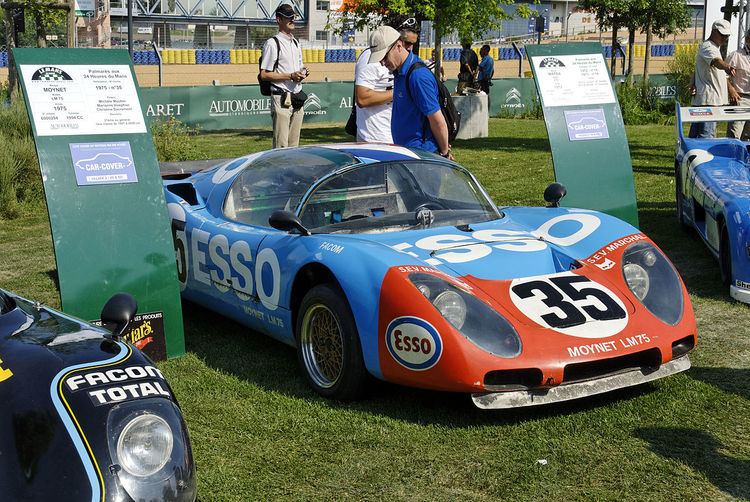 | ||
The 1975 24 Hours of Le Mans was the 43rd Grand Prix of Endurance, and took place on 14 and 15 June 1975.
Contents
Pre-race
In the wake of the oil crisis, Le Mans introduced rules in 1975 regarding fuel consumption. In response, the CSI excluded the 24 Hours from the World Championship for Makes. The rules required cars to go a minimum of 20 laps between refueling, along with the use of mandated fuel tank sizes. These regulations would be a predecessor to the Group C era of the 1980s.
Running at lower RPM to match the fuel limitation, a Cosworth DFV engine could be reliable on 24 hours. John Wyer had planned his retirement but he couldn't resist to the opportunity to win Le Mans again, and he chose not to retire this year and to make Le Mans the sole race of the Gulf team program for the 1975 season. Two new Gulf GR-8's were designed and constructed especially for Le Mans, largely a derivative of the Gulf GR-7 but with new bodywork giving up-to-date aerodynamics optimized for Le Mans and fuel efficiency. With the technology of Gulf that could provide specially tuned fuel, the Gulf team were by far the favorite.
The new rules were also an opportunity for Guy Ligier who had previous experience in racing a Cosworth at Le Mans. As Matra had withdrawn from competition, Ligier managed to acquire the services of Matra's engineer Gérard Ducarouge, and the sponsorship of Gitanes. The sales of Ligier road going JS-2 had decreased drastically with the oil crisis, and the team was preparing his entry in Formula One for 1976. This left limited financial and engineering means for endurance racing. Ligier made the choice to run the race with the experienced Ligier JS-2's chassis fitted with DFV engines and Hewland gearboxes. In terms of performance the Gulf prototypes were clearly superior to the Ligier that were initially designed in 1971 as Maserati-powered road-cars and hacked as Cosworth-powered prototypes in 1975. Achieving superior reliability was the sole chance for the team to gain advantage over the Gulfs. Ligier chose to run some races of the World Championship before Le Mans as tests runs for the Cosworth-powered JS-2.
Gulf entered 2 GR-8's in Le Mans while Ligier entered 2 JS-2 Cosworth and one JS-2 Maserati. Both rivals had seriously downgraded their DFV engines: the Gulf had around 380 hp (280 kW), while the Ligiers had 420 hp (310 kW) to compensate some of their handicap.
Alpine-Renault entered one 2.0L A441 C with an all-women team. As the A441 was probably the best 2.0L car of that era and 2.0L cars weren't much restrained by fuel limitation, this car was a serious outsider.
Porsche made a minimal effort, being represented only by private teams. The rest of the opposition consisted in a brand new and very aerodynamic-looking Lola T380-Cosworth entered by the gentleman-driver Alain de Cadenet, partnering Chris Craft. De Cadenet was here to finish, according to various sources he had limited his DFV RPMs so low that the engine wasn't able to deliver more than 350 hp.
Race
Without surprise, the two Gulfs took the lead of the race. Vern Schuppan and Jean-Pierre Jaussaud had an alternator failure and went six laps down to teammates Jacky Ickx and Derek Bell. Near midnight the brand-new de Cadenet Lola was where it was expected to be, in third position, but the car lost its entire rear bodywork on the straight. François Migault hit it at full stride with his Ligier. After nearly an hour's repairs attempts, the Ligier coupé retired. The Lola carried on; by luck the engine cover had missed the rear wing completely.
Not long after 2:30 p.m. Ickx pitted to repair a broken exhaust pipe, the repairs were completed as the remaining Ligier entered the lead lap. During the race the V8 powered Ligiers were also plagued by broken exhaust pipes due to DFV's destructive vibrations to a worse extent that the Gulf but with the experience gained in other races and a design of the exhaust system allowing quicker parts exchange, they lost less time in the pits than the Gulfs.
The Gulf GR-8 driven by Ickx and Bell won the race. The other Gulf had mechanical problems and finished third, leaving second position to a Ligier piloted by Guy Lafosse and Guy Chasseuil. The gap between the winning Gulf and the Ligier was only one lap.
De Cadenet's Lola was 14th, finishing the race with a bodywork stuck together with a lot of adhesive tape. De Cadenet came back in 1976 with the same chassis updated with major bodywork modifications finishing third for what remains the best result of de Cadenet at Le Mans, and the best result of a Lola chassis.
Reinhold Joest, Jürgen Barth, and Mario Casoni were fourth in their aged Porsche 908/3.
Disqualified
Replenished the car's oil before the allowable time.
